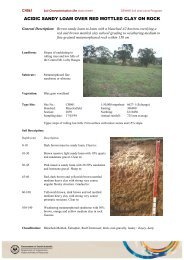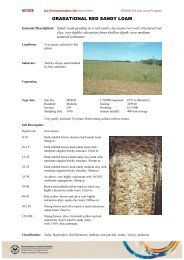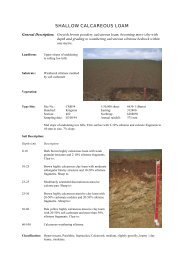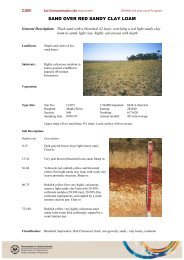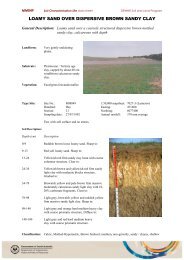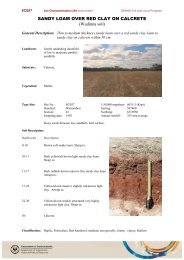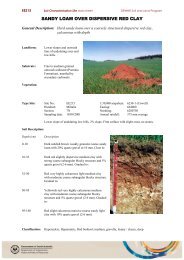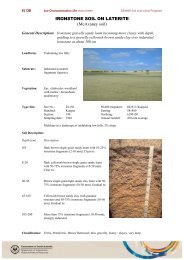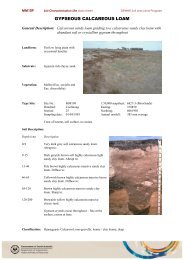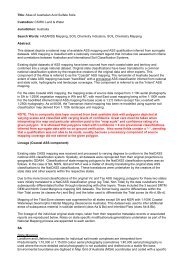You also want an ePaper? Increase the reach of your titles
YUMPU automatically turns print PDFs into web optimized ePapers that Google loves.
3 Development of <strong>ASRIS</strong><strong>ASRIS</strong> was initiated through the National Land and Water Resources Audit (NLWRA) in 1999 (see NLWRA2002, Henderson et al. 2002). The initial release (<strong>ASRIS</strong> 2001) provided primary inputs for a broad range ofsimulation modelling studies supported by the NLWRA. These studies provided continental perspectives onerosion, sediment delivery to streams, nutrient cycling, acidification, net primary productivity, and waterquality (NLWRA 2001, 2002).The <strong>ASRIS</strong> 2001 team achieved a great deal given the short time available and daunting nature of the task(see Johnston et al. 2003). During the project, the core team and the National Committee on Soil andTerrain (NCST) (which acted as the Steering Committee) identified a series of deficiencies in the landresource information base for Australia. They also identified a logical pathway for overcoming theseproblems to ensure a greatly improved system for providing information to support natural resourcemanagement in Australia. The task was recognized to be long-term, and requiring a permanent projectteam (NLWRA 2002).With this background, the Australian Collaborative Land Evaluation Program (ACLEP) was commissioned bythe Department of Agriculture, Fisheries and Forestry (DAFF) to provide land managers, regionalorganizations, industry partners, policy specialists and technical experts in natural resource management,with online access to soil and land resource information, and assessments of land suitability. 1 Theinformation is to be available at a range of scales, and in a consistent and easy-to-use format acrossAustralia. The activity must also provide a scientific framework for assessing and monitoring the extent andcondition of Australia’s soil and land resources.<strong>ASRIS</strong> provides the following:• A hierarchy of land units for the Australian Soil Resource Information System to allow comprehensivereporting on soil resources and land suitability from the National down to the Subregional scale. Upperlevels of the hierarchy are generated using refinements of existing geomorphic maps and digital terrainanalysis. Other information sources include results from continent-wide calculations of the waterbalance and geologic mapping. Lower levels are derived from the contributing state, territory andfederal soil and land databases. There is also the facility to display information on soil and land inrelation to other high-level stratifications including the Interim Biogeographic Regions of Australia(v6.1), Groundwater Flow Systems, and catchment management boundaries.• Consistent soil and land attributes are presented for units at the lowest levels in the hierarchy andthese are used to generate summaries for higher-level units. The land qualities relate to the intrinsiccapability of land to support various land uses – they relate to soil depth, water storage, permeability,fertility, and erodibility.• <strong>ASRIS</strong> is updated regularly. Check the website (www.asris.csiro.au) for the latest information (seehttp://www.asris.csiro.au/new.html). <strong>ASRIS</strong> uses SQL Server, the Arc Spatial Data Engine (ArcSDE), ArcInternet Map Server (ArcIMS) and ArcGIS Server.• <strong>ASRIS</strong> is compliant with standards agreed by the Open GIS Consortium. It hosts web map services(WMS) that enable integration with online viewers such as Google Earth and NASA World Wind.• <strong>ASRIS</strong> includes a soil profile database with fully characterized sites that are known to be representativeof significant areas and environments. The profile database will be revised and expanded.1 The term land capability was used in the original brief – this term is usually associated with the United States Department of Agriculture eight-classsystem for classifying land. The term land suitability is preferred here (see Dent and Young 1981, McKenzie 1991).9




